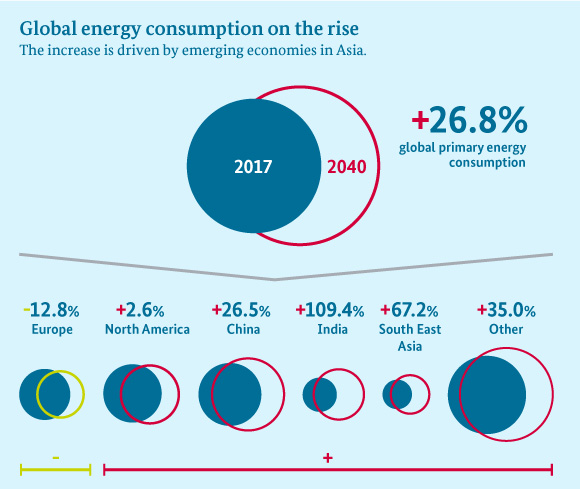IEA: Global energy consumption to rise by more than a quarter up to 2040
As the world's population and global incomes keep growing, primary energy consumption is expected to rise by more than a quarter by 2040. The International Energy Agency (IEA) has calculated that emerging economies in Asia will account for most of this increase in demand.
 © BMWi, Data from WEO 2018, International Energy Agency
© BMWi, Data from WEO 2018, International Energy Agency
Every year, the IEA publishes its World Energy Outlook (WEO), which provides sound analyses relating to future developments in the global energy sector. This is not about foretelling the future. Instead, the WEO provides various different scenarios. The New Policy Scenario, for instance, is based on the assumption that government policy will be implemented as announced and targets reached. Our infographic is based on data extracted from this scenario.
Constant improvement on energy performance is absolutely key
Under this scenario, global energy consumption will increase by 27% by 2040, from 14,000 to 17,700 million tonnes of crude oil equivalent. This increase will be driven by population growth (+ 1.7 billion people) and rising prosperity levels across the world. The report states that the increase would be roughly twice as much if it were not for a constant improvement of energy performance levels. Despite this greater efficiency and despite a global increase in the use of renewables, the political action that has so far been announced by governments across the globe is not nearly drastic enough for the global community to reach its climate targets.
According to the WEO, all of the rise in global energy consumption will be attributable to emerging economies, especially India. Energy consumption in the country is set to rise from 898 million tonnes of crude oil equivalent in 2017 to a predicted 1,880 million tonnes, i.e. by 109.4%. China’s energy consumption is expected to rise by 26.5%, from 3,051 to 3,858 million tonnes of crude oil equivalent. During the same period, Europe will be reducing its consumption by 12.8%, from 2,008 to 1,752 million tonnes of crude oil equivalent.
The WEO report states that: "None of these potential pathways is preordained; all are possible. The actions taken by governments will be decisive in determining which path we follow."

